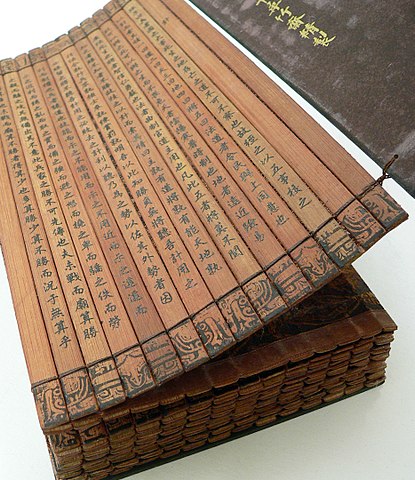Literature
The Realm has a long history of the written word, but it is only within the past 100 years that writing has become as widely accessible as it is today.
A History of the Written Word

For the first centuries of the Realm, during the recovery from the Thousand Tragedies and reinvention of Shogunate technology, the most common produced book was a bamboo slip book, produced by lacing several long strips of bamboo together. Handwritten scrolls and hand-copied books were also produced, mostly for governmental purposes.
In the fourth century, the Realm’s printmakers developed effective methods of woodblock printing that allowed for reproduction of books. Across the next few centuries, the woodblock methods were refined through more advanced paper blends, mechanization of the pressing process, and other marginal improvements. All of these techniques gradually decreased the price of books. As books became cheaper, the Immaculate Order increased their literacy education, which in turn drove more demand for books.
The printing process, however, still remained bottlenecked at a stage well before ink touches paper. Woodblock printing relies on wooden templates against which the pages are pressed to mark them with ink. For centuries, the only way to produce these blocks was to contract an artisan to produce each individual template by hand. The templates were large, sturdy wooden blocks that took up a lot of space, and each individual page of each individual book requires its own template.
In RY 690, the Realm discovered and conquered the port of Wu-Jian, and opened the Great Western Ocean to reasonable exploration within a mortal lifetime. A mortal woodblock maker and scion of House Nellens, Nellens Maqi, used new woodworking techniques imported from the West to finally produce his facsimile machine. The Nellens facsimile machine is able to mechanically reproduce woodblock templates from a single installed master template. Facsimile templates are also smaller, thinner, and double-sided, which significantly reduces the amount of space required to store a whole set of book pages.
The eighth century has been an absolute revolution in literature for the Realm. The facsimile machine has reduced books from luxury items to finally within the reach of craftsmen families, which has lead to a staggering increase in the number of casual readers. The Order has also doubled down on literacy education, producing hundreds of sanctioned pamphlets to encourage the Order’s preferred interpretations. Thanks to the facsimile machine and other mechanical methods for printing, the Blessed Isle produces cheaper literature than anywhere else in Creation. In major cities with a printing center, paper-bound chap books can be purchased for the price of a nice meal, and proper covered books for a little more.
Classical Fiction
The Great Classics are six novels which have been in print more or less continuously since the earliest days of the Realm. Some of these novels originate from Shogunate authors; others originate from the early centuries of the Realm and have simply become established. These six novels were the most widespread non-religious non-governmental literature available in the form of books and scrolls until the recent printing revolution.
Some of the Great Classics, like the bandit adventures of Low Tide Moon or the political situations and grand battles of The Gate at Peach Mountain Pass, purport to be historical accounts, but are identified by contemporary scholars as containing highly fictionalized details. Some others, like the fictitious House chronicle Western Garden, are understood to be wholly fictional and completely divorced from reality. The comedies, like Favorable Doldrums, are generally more likely to acknowledge their own fiction than the more serious Great Classics.
Popular Fiction
Popular fiction ranges from gory military fiction to romanticized epics to steamy romances bound with blue covers. In general, the Realm’s popular fiction can be divided into the categories of peasant fiction and respectable fiction. The difference is obvious: respectable fiction is what the Dynasty reads, peasant fiction is what peasants read.
The Dynasty’s refined literature comes in many forms like comedies of manners, novels of manners, and, of course, romances of manners. Beyond that, the Dynasty also widely enjoys the well-written fictionalized accounts of great periods of the Shogunate, and the less refined elements of the Dynasty can be found reading adventure novels which tell of exotic places they may one day rule. A small number of Dynasts have committed themselves to publishing and discussing the most worthy works emerging from the satrapies, but such things are trivialities.
Peasant fiction, on the other hand, is completely devoid of the refined experiences of Dynastic fiction. Galavanting heroes prance about through uncomplicated narratives. Tall tales and accounts like the dishonorable nobles of The Tales of Magistrate Shining Eye – based on the real lost egg Magistrate Shining Eye in the third to fifth centuries – give rise to unhealthy opinions. And of course, one must not even consider the salacious romances which can be found throughout the Isle’s major cities. Certainly no Dynast has ever read such a steamy and disreputable novel in some sealed chamber somewhere.
Poetry
The Realm has a rich poetic tradition which permeates the Dynasty. Poetry is one of the most noble pursuits an artist can devote herself to, which gives rise to an extensive body of poems.
Most poems in the Realm are composed in High Realm, and rely on tricks like tone sandhi, homonymy, and similar turns of phrase to convey layered meaning. The southern reaches of Arjuf and Radimel’s Seat both have rich native traditions of poetry in their own languages. Arjufi poetry is flowing and grand, full of parallelism and heroism. Radimel’s Seat’s poetry is often on the verge of theater, set to music and recited by elders.
The peasantry do not understand poetry and prefer novels. It is because they are unable to appreciate the subtlety of a good poem.